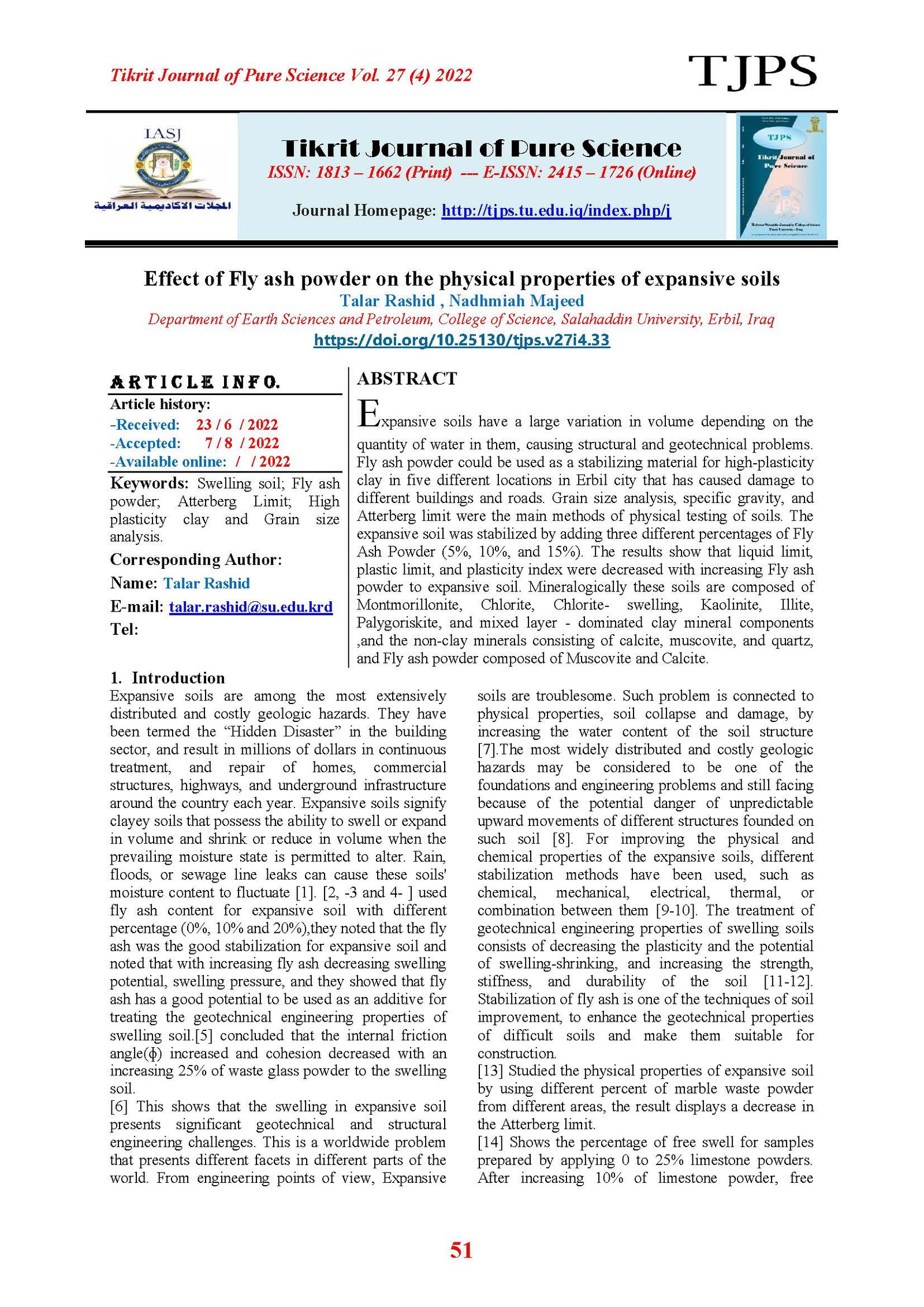Effect of Fly ash powder on the physical properties of expansive soils
Main Article Content
Abstract
Expansive soils have a large variation in volume depending on the quantity of water in them, causing structural and geotechnical problems. Fly ash powder could be used as a stabilizing material for high-plasticity clay in five different locations in Erbil city that has caused damage to different buildings and roads. Grain size analysis, specific gravity, and Atterberg limit were the main methods of physical testing of soils. The expansive soil was stabilized by adding three different percentages of Fly Ash Powder (5%, 10%, and 15%). The results show that liquid limit, plastic limit, and plasticity index were decreased with increasing Fly ash powder to expansive soil. Mineralogically these soils are composed of Montmorillonite, Chlorite, Chlorite- swelling, Kaolinite, Illite, Palygoriskite, and mixed layer - dominated clay mineral components ,and the non-clay minerals consisting of calcite, muscovite, and quartz, and Fly ash powder composed of Muscovite and Calcite.
Article Details

This work is licensed under a Creative Commons Attribution 4.0 International License.
Tikrit Journal of Pure Science is licensed under the Creative Commons Attribution 4.0 International License, which allows users to copy, create extracts, abstracts, and new works from the article, alter and revise the article, and make commercial use of the article (including reuse and/or resale of the article by commercial entities), provided the user gives appropriate credit (with a link to the formal publication through the relevant DOI), provides a link to the license, indicates if changes were made, and the licensor is not represented as endorsing the use made of the work. The authors hold the copyright for their published work on the Tikrit J. Pure Sci. website, while Tikrit J. Pure Sci. is responsible for appreciate citation of their work, which is released under CC-BY-4.0, enabling the unrestricted use, distribution, and reproduction of an article in any medium, provided that the original work is properly cited.
References
[1] El Sharif, M. A., Taha, Y. K., Kenawi, M. A., & Kamel, A. O. (2013). Treatment of expansive soil with chemical additives. J. Eng. Sci. Assiut Univ. F ac. Eng, 41(5), 1765-1777.
[2] Phanikumar, B.R., Mani, A.J., Sathiyasheelan, S. and Rajesh Reddy, P., 2009. Fly ash columns (FAC) as an innovative foundation technique for expansive clay beds. Geomechanics and Geoengineering: An international journal, 4(3), pp.183-188.
[3] Sivaramakrishnan, V., Bidula, S., Campwala, H., Katikaneni, D. and Fountain, S.J., 2012. Constitutive lysosome exocytosis releases ATP and engages P2Y receptors in human monocytes. Journal of cell science, 125(19), pp.4567-4575.
[4] Sabat, A.K. and Mohanta, S., 2016. Performance of limestone dust stabilized expansive soil-fly ash mixes as construction material. Int. J. Civ. Eng. Technol.(IJCIET), 7(6), pp.482-488.
[5] Mawlood, Y.I., 2020. Approaches to Predict Swelling Behaviours of Erbil Soils (Doctoral dissertation, Salahaddin University-Erbil).
[6] Khademi, F. and Budiman, J., 2018. Expansive soil: causes and treatments. i-Manager's Journal on Civil Engineering, 6(3), p.1.
H550CEGNeMontmorilloniteC-MChkorite swellingPalygoriskiteKaoliniteIntensity2 Theta
[7] Audu, H.A.P. and Okovido, J.O., 2019. Experimental Study on Effect of Lime and Cement Stabilizers on Geotechnical Properties of Lateritic Soil. International Journal of Engineering Research and Advanced Technology (IJERAT), 5(4), pp.9-15.
[8]Abdulla, R. and Majeed, N., 2021. Enhancing Engineering Properties of Expansive Soil Using Marble Waste Powder. The Iraqi Geological Journal, pp.43-53.
[9]Al-Joulani, N., 2012. Effect of stone powder and lime on strength, compaction and CBR properties of fine soils. Jordan Journal of Civil Engineering, 6(1), pp.1-16.
[10] Liu, S., Lu, Y., Weng, L. and Bai, F., 2015. Field study of treatment for expansive soil/rock channel slope with soilbags. Geotextiles and Geomembranes, 43(4), pp.283-292.
[11]Afrin, R., Arumugam, S., Rahman, A., Wahed, M.I.I., Karuppagounder, V., Harima, M., Suzuki, H., Miyashita, S., Suzuki, K., Yoneyama, H. and Ueno, K., 2017. Curcumin ameliorates liver damage and progression of NASH in NASH-HCC mouse model possibly by modulating HMGB1-NF-κB translocation. International immunopharmacology, 44, pp.174-182.
[12] Behnood, A. and Golafshani, E.M., 2018. Predicting the compressive strength of silica fume concrete using hybrid artificial neural network with multi-objective grey wolves. Journal of Cleaner Production, 202, pp.54-64.
[13] Thyagaraj, T. and Zodinsanga, S., 2014. Swell–shrink behaviour of lime precipitation treated soil. Proceedings of the Institution of Civil Engineers-Ground Improvement, 167(4), pp.260-273.
[14]Abdulla, R.S. and Majeed, N.N., 2014. Some physical properties treatment of expansive soil using marble waste powder. Int J Eng Res Technol, 3(1), pp.591-600.
[15] Nguyen, D.T. and Nu, N.T., 2020. Effect of different types of rice husk ash on some geotechnical properties of cement-admixed soil. The Iraqi Geological Journal, pp.1-12.,
[16] ASTM, D., 1998. 698-91e1. Standard Test Method for Laboratory Compaction Characteristic of Soil Using Standard Effort, ASTM, Annual Book of ASTM standard, Section 4: Construction, vol. 04.08: Soil and rock (I): D420-D4914. Am. Soc. Testing and Materials, Philadelphia.
[17] Astm, D., 2007. 422-63. Standard test method for particle-size analysis of soils. Annual book of ASTM standards, 4, pp.10-16.
[18] Francis, J., 1851. Chronicles and characters of the Stock Exchange. Longman, Brown, Green, & Longmans.
[19]Brindly, G.W. and Brown, G., 1980. Crystal Structures of Clay Minerals and their X-ray Identification, Miner. In Society, London (p. 495).
